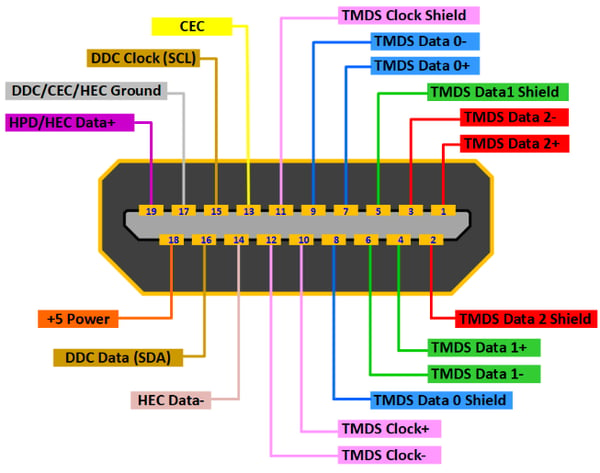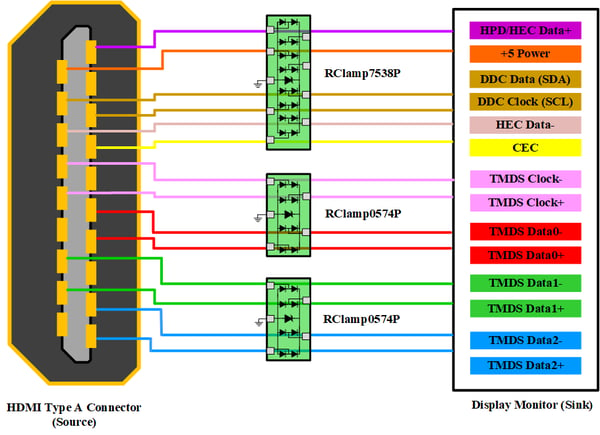ESD Protection for HDMI 2.0
During the ongoing Coronavirus pandemic when we are mostly confined to our homes, we are spending an increased amount of time in front of screens. This includes attending online meetings, taking video calls, playing video games, watching television, and also working longer hours on our computers. A high quality audiovisual (AV) experience is a must these days and thanks to the high definition digital displays and high definition multimedia interfaces (HDMI), we are able to experience high speed, high resolution AV with higher pixel depths and greater aspect ratios.
HDMI is a digital interface for transmitting high definition, high speed digital multi-track audio and uncompressed video signals from HDMI-compliant sources to other AV displays. Since the release of HDMI in 2002, it has gained widespread acceptance in consumer electronics. Today, HDMI connects computers, gaming consoles, Blu-ray/DVD players, televisions, projectors, home entertainment systems, display monitors, and many other AV appliances.
HDMI System Architecture & Pin Configurations
HDMI system architecture consists of a cable with connectors at the source and the sink, as shown in Figure 1. High resolution uncompressed video, audio and control signals are transmitted via one single HDMI cable. Let us analyze the system architecture on how the data is transferred from the source to the sink.

Figure 1. HDMI System Architecture
The transition minimized differential signaling (TMDS) algorithm is used to transmit the video and audio signals from the transmitter to the receiver. This algorithm uses four differential pairs. Three of them are TMDS data channels and one is the TMDS clock channel. Each TMDS data channel is composed of data+, data- and data shield. The TMDS clock channel is composed of clock+, clock- and clock shield. TMDS channels are synchronized with reference to the clock channel.
Display Data Channel (DDC) is a bidirectional communications protocol between an HDMI-compatible device and a source that allows the source to read the identification data of the peripheral. It provides information such as model number, serial number, aspect ratio, and more. The DDC bus is based on the Inter Integrated Circuit (I2C) bus. It consists of a serial clock or SCL, a serial data or SDA line and a ground connection.
The Consumer Electronics Control (CEC) is a bidirectional bus to control or connect other CEC-capable devices from one source. CEC contains a single wire and a ground that it shares with DDC and HEC.
A +5V power line is used to supply power to the DDC bus of the sink when the power is not turned on. Let us consider that a laptop computer is connected to a projector via HDMI connector. The +5V power line will power up the DDC line of the projector even if the projector is not turned on. This will enable the laptop computer to read the information from the projector.
Hot Plug Detection (HPD) and HDMI Ethernet Channel (HEC) Data+ share the same line. HPD allows a source to detect if any HDMI enabled device is connected or removed while in operation. HEC is used for Ethernet compatible data networking between devices.

Figure 2. Pin configuration of HDMI Type A Connector
Figure 2 shows the pin configuration of a standard Type A HDMI connector. It contains 19 pins including four TMDS pairs and six other channels (+5V power, HPD, CEC, SDA, SCL, HEC) to fulfill the digital data transition. Since its introduction in 2002, HDMI has progressed to many specifications, however, HDMI 2.0 is still the most popular and widely used interface.
ESD Protection of HDMI 2.0 Interfaces
HDMI 2.0 is designed to augment the AV experience for viewers by increasing the bandwidth significantly from previous versions. The maximum bandwidth of a TMDS channel is 6Gbps. The three TMDS channels are capable of total 18Gbps differential data transfer with resolutions up to 4K at 60 frames per second. They can deliver digital data up to two video streams and up to four audio streams. As consumers expect uninterrupted video and also plug and unplug HDMI connectors frequently, the EMC robustness of the HDMI interface is critical. These plug-unplug events can cause ESD events that can reach up to thousands of volts potentially damaging the electrical circuit. The TVS diode protects data ports from ESD threats by arresting the system-level ESD peak within a nanosecond, thereby diverting high currents away from the data port.
Now let us explore how we can protect the HDMI port from any ESD event. The 19 pins/channels in an HDMI Type A port shown in Figure 2 can be categorized into high-speed channels and non-high-speed channels. High-speed channels include the TMDS channels (Pin 1-2-3; 4-5-6; 7-8-9) and the TMDS clock channel (Pin 10-11-12). These channels carry differential data signals totaling 18Gbps.
The maximum operating voltage on each differential line is 3.3V. Since these are extremely high-speed differential data lines, TVS diodes need to protect the circuit during transient events by maintaining an extremely low line-to-line capacitance while ensuring the signal integrity. As the TVS diode and the electrical circuit are connected in parallel, during an ESD event, the voltage drop across the circuit is same as the clamping voltage of the TVS diode. It is vital to keep the clamping voltage as small as possible. Therefore the protection device should include features like low ESD peak clamping voltage and low dynamic resistance. Additionally, the signal integrity of the high-speed interface can be optimized by choosing TVS devices that feature a flow-through routing package. This is extremely important to avoid signal distortion.
Semtech’s RClamp®0574P is specifically designed to protect the high-speed differential lines of HDMI 2.0 interfaces. It protects four high-speed data lines with a typical junction capacitance of 0.18pF. It has an operating voltage of 5.5V with a minimum breakdown voltage of 6.5V. RClamp0574P provides transient protection as per the specification in IEC 61000-4-2 (ESD) at ±15kV (Air), ±10kV (Contact). It has a dynamic resistance of 0.26Ω (Typical). RClamp0574P is available in a 5-pin DFN package with a nominal dimension of 2.0 x 1.0 x 0.5mm. Since one RClamp0574P can protect two differential data pairs, two RClamp0574P can be used to protect the three TMDS channels and the TMDS clock channel as shown in Figure 3. The flow-through package design of the device simplifies the PCB layout and helps maintain the signal integrity.
Now let us see how to protect the rest of the six channels which are non-high-speed. These channels include CEC (Pin 13), HEC (Pin 14, 19), SCL (Pin 15), SDA (Pin 16), +5V power (Pin 18), and HPD (Pin 19). These channels can be protected by RClamp0574P as well, however, since these channels do not transmit high-speed data, low capacitance is not as critical for their protection during transient events. To protect these channels, a six channel TVS diode array is required with an operating voltage of 5V, fast response time, low clamping voltage, and no device degradation during the transient event.
Semtech’s RClamp7538P is perfectly suited to safeguard these six channels. It has a working voltage of 5V with peak pulse current of 5A. RClamp7538P provides transient protection as per the specification in IEC 61000-4-2 (ESD) at ±25kV (Air), ±20kV (Contact). It has a typical dynamic resistance of 0.42Ω. It comes in a nine-channel DFN package of size 3.8 x 1.0 x 0.5mm. The state-of-the-art flow-through scheme is also used for the package design which simplifies the PCB layout using this part. Refer to the connection diagram in Figure 3 below.

Figure 3. Possible ESD protection options of HDMI 2.0 connection
Summary and Conclusion
It is essential that the HDMI ports are adequately protected from all ESD threats. No user wants to experience a damaged computer monitor or a home entertainment system due to an ESD event. Semtech’s highly efficient and trusted TVS products shield many of the world’s most popular display devices. These solutions are ideal for safeguarding HDMI 2.0 interfaces – enabling consumers to enjoy a smooth uninterrupted experience interfacing their high-fidelity AV devices.
Watch a video tutorial on this topic:

Subscribe to the blog for future updates on circuit protection from Semtech.
Semtech®, the Semtech logo and RClamp® are registered trademarks or service marks of Semtech Corporation or its affiliates. Other product or service names mentioned herein may be the trademarks of their respective owners.


